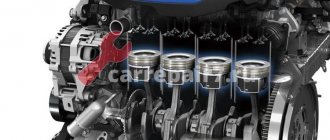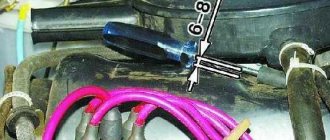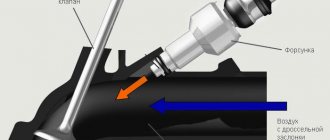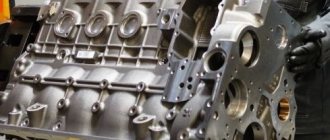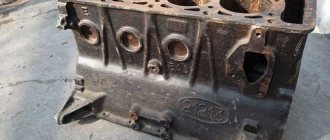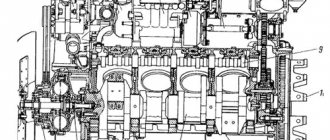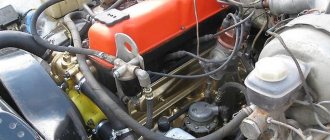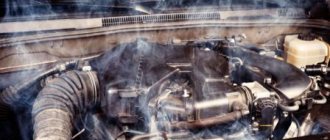I propose to discuss the new eight-valve engine with the VAZ-21116 index - this is a deep modernization of the 1.6-liter engine (VAZ-21114). When buying a car, I heard a lot about the upgraded engine from Granta (the norm). I knew that some kind of lightweight piston group was installed. Winter has come :), I have more time and decided to learn more about the engine. I am pleased with everything that the designers have done with the modernization of the engine, and the fact that the H-intake module has been improved, the pistons have been lightened, the collector has become quieter, and the timing belt tensioner has become automatic. Everything is great except the big one BUT
, which constantly keeps you in suspense.
When the timing belt breaks, the valves bend
and lead to expensive repairs. I’m not used to thinking positively about the domestic engine industry. The manufacturer promised that the timing belt will last 200,000 km, which is hard to believe. And the coolant pump has been improved. I don’t believe that it won’t require replacement no sooner than the car has run 180,000 km. As a rule, a pump malfunction provokes a break in the timing belt. The day before yesterday, a neighbor complained that the timing belt on his car (VAZ-2114) had broken. Work for an hour, replaced with a new one and back on the road. This won't work on Grant anymore. It is necessary to constantly inspect the condition of the timing belt and the condition of the coolant pump. It is well written about the engine HERE: www.zr.ru/a/422396/ cooling system: www.vwts.ru/cooling/cooling_syst_el_regul_rus.pdf
What is your opinion?
This engine on cars of the first years of production had the index 21116, later, without significant technical changes, it received the index 11186, maintaining all its indicators. According to some information, the change in the index is associated with a change in the supplier of the connecting rod and piston group; if in engine 21116 the supplier was Federal Mogul, then in the engine with index 11186 AvtoVAZ independently mastered the production of ShPG.
Engine 21116 is another representative of the power units produced for the Lada Granta. It is considered one of the best representatives of the AvtoVAZ production family. Production of the power unit began in 2011 and continues.
Specifications and description
The VAZ 21116 engine is a direct successor to the Kalinovsky engine 11186, modernized and improved. But, the main base of the engine belongs to the legendary Zhigulevsky engine - VAZ 21083.
So, let's look at the main technical characteristics of the 21116 motor:
| Name | Characteristic |
| Brand | 21116 |
| Marking | 1.6 (1596 cm cube) |
| Power | 87 horsepower |
| Type | Injection |
| Fuel | Petrol |
| Valve mechanism | 8 valve |
| Number of cylinders | 4 |
| Fuel consumption | 7.2 liters |
| Piston diameter | 82 mm |
| Resource | 200 - 250 thousand km |
Engine VAZ 21116-100026080. Characteristics of the VAZ 21116 engine.
The engine is four-stroke, with distributed fuel injection, in-line, with an overhead camshaft. The engine cooling system is liquid, closed type, with forced circulation of liquid. The engine has a combined lubrication system: pressure and splash.
| Number of cylinders: | 4 |
| Cylinder displacement, l: | 1,597 |
| Compression ratio: | 10,5 |
| Rated engine power at a crankshaft speed of 5600 rpm: | 66 kW.-(90.0 hp) |
| Cylinder diameter, mm: | 82 |
| Piston stroke, mm: | 75,6 |
| Number of valves: | 8 |
| Minimum crankshaft speed, rpm: | 800-850 |
| Maximum torque at 3500 rpm, N*m: | 143 |
| Cylinder operating order: | 1-3-4-2 |
| Octane number of gasoline: | 95(unleaded) |
| Fuel supply system: | Electronically controlled distributed injection. |
| Spark plug: | A17DVRM, BPR6ES(NGK) |
The VAZ 21116 engine is developed on the basis of the 21114 (11183) model. Assembly of small batches has been carried out since June 2011. Serial production of the engine is scheduled for October 2011. The engine is planned to be installed on the LADA Granta in the “Norma” configuration. The new motor is considered as a replacement for models 21114 (11183).
The LADA Granta engine - VAZ 21116, has a cylinder block with a height of 197.1 mm. To finish the surface of the block cylinders, plate honing is used (as on block 21126). For more intensive cooling of the pistons, oil nozzles are provided in the block.
Crankshaft mod. 11183 has a crank radius of 37.8mm. Changing the timing drive required the use of a new spacer washer on the crankshaft (21116 -1005317) for the correct position of the pulleys.
The LADA Granta VAZ 21116 engine uses a connecting rod and piston group from Federal Mogul - 21116 -1004010. Original piston mod. 21116, connecting rod model 11194 (used in the ShPG 21126 kit), piston rings with a height of 1.2/1.5/2 mm. As a result, a significant reduction in the mass of the connecting rod and piston group was obtained, which influenced the improvement of the main technical indicators - increased power, reduced vibration and noise, and reduced specific fuel consumption.
The new 8-valve cylinder head has the index “11186”. The head has additional mounting points for the new timing belt tensioning mechanism. There are differences in the platform and in the fastening of the receiving pipe. Hydraulic valve lifters are not provided.
The head gasket is new 21116-1003020-00, metal two-layer (similar to mod. 21126), thickness 0.43 mm.
For the timing drive, a belt 21116-1006040-00 manufactured by Gates is used, with a width of 22 mm and a service life of 200 thousand km (according to the manufacturer). The use of a new belt required the introduction of new parts into the engine design:
automatic toothed belt tensioner – 21116-1006238-00;
crankshaft gear pulley – 21116-1005030-00;
camshaft gear pulley – 21116-1006020-00.
The motor is equipped with a new intake module 21116-1008600, with a new mounting bracket. At the outlet, a new muffler exhaust pipe with neutralizer 21116-120300815 is installed. The engine complies with Euro 3 environmental requirements.
The ignition system of the VAZ 21116 engine does not use individual coils and, in general, it corresponds to the system of the VAZ 21114 engine.
The VAZ 21116 engine installed on the LADA Granta allows you to obtain the following characteristics for the car:
— fuel consumption in the urban cycle: 8.5 liters. per 100 km;
— fuel consumption on the highway: 5.7 liters. per 100 km;
— maximum speed: 167.0 km/h.
Installation of engine ignition 21116:
Service
Maintenance 21116, typical for cars produced by AvtoVAZ. The main maintenance operations are changing the oil and oil filter. To change the lubricant, 3.2 liters of engine oil is required. In turn, 3.5 liters of lubricant fits into the engine.
It is recommended to fill in semi-synthetic motor oils marked 5W-30, 5W-40, 10W-40, 15W40.
The maintenance map looks like this:
TO-1: Oil change, oil filter replacement. Carry out after the first 1000-1500 km. This stage is also called the break-in stage, since the engine elements are grinding in.
TO-2: The second maintenance is carried out after 10,000 km. So, the engine oil and filter are changed again, as well as the air filter element. At this stage, the pressure on the engine is also measured and the valves are adjusted.
TO-3: At this stage, which is performed after 20,000 km, the standard procedure for changing the oil, replacing the fuel filter, as well as diagnosing all engine systems is carried out.
TO-4: The fourth maintenance is perhaps the simplest. After 30,000 km, only the oil and oil filter element are changed.
TO-5: The fifth maintenance is like a second wind for the engine. This time a lot of things are changing. So, let's look at which elements need to be replaced in the fifth maintenance:
- Change of oil.
- Replacing the oil filter.
- Replacing the air filter.
- Replacing the fuel filter element.
- The timing belt and roller are replaced.
- Alternator belt if necessary.
- Water pump.
- Valve cover gasket.
- Other items that need to be replaced.
- Valve adjustment, which adjusts the gas distribution mechanism.
Subsequent maintenance is carried out according to the 2-5 maintenance map for the corresponding mileage.
Why does the Granta 8 valve bend the valve?
The breakdown procedure itself is also equally important to study. Having understood which areas are most susceptible to damage, the owner will be able to pay more attention to them or seek help from specialists
After diagnostics, our technicians will perform a full service and help you avoid numerous causes of timing belt failure: jamming of the pump, rollers, camshaft or crankshaft. The process of valve damage itself occurs according to the following scheme:
1. The timing belt breaks.
2. The camshaft stops.
3. The crankshaft continues to rotate (the flywheel transmits rotation).
4. The pistons hit the open valves when the timing belt breaks.
Thus, the valves become bent, and in the future they will need to be completely replaced. You can also find out whether the valves of the Lada Granta 8 valve are bent from specialists working at the service station.
After all, a breakdown does not necessarily affect every owner of a domestic car. Damage occurs in exceptional cases when the motorist does not devote enough time to servicing the car. Therefore, the root cause is insufficiently conscientious operation.
Many craftsmen recommend that immediately after purchasing a Granta, you have it checked at a service station, since even small nicks on the shafts can lead to a rupture of the timing belt.
In some cases, changing the belt to a stronger one helps: the factory component may not meet the required load and operating conditions. The tension force must fully comply with the stated recommendations of the manufacturers. Therefore, self-regulation can only worsen the situation.
You should also contact a specialist if primary signs appear that may indicate a subsequent belt rupture. It could be minor noise from the timing drive. It is this that will indicate possible wear or partial wedge of the rollers or pump.
All these factors are decisive and can lead to the need for expensive repairs, and in extreme cases, to calling a tow truck if the driver was outside the city at the time of the rupture. The owner of the Grant needs to take into account all the considered nuances and solve the slightest problems immediately after they arise.
Malfunctions and repairs
ICE 21116 is based on the 21114 power unit. Unlike its older brother, the piston group is produced by Federal Mogul, which made it possible to lighten the ShPG by 39%. If the timing belt breaks, the valve must bend. These are perhaps serious shortcomings. If the valves are bent, then a major overhaul of the cylinder head is guaranteed.
Frequent malfunctions of 21116 are tripping, and poor starting is due to poor quality of the ignition system and the formation of an air-fuel mixture that does not burn completely.
But these malfunctions are typical for all AvtoVAZ representatives. In this case, the car may still be under warranty service.
Dynamics
External view of engine 21116
This is not a racing car, but there is enough power for both city driving and highway driving. If we compare it with the 16-valve engine of the Lada Granta, which is installed on the Luxury versions, then it has more torque at the bottom. This means that you can drive in 5th gear at a speed of 40 km/h.
For example, you are driving at 5 speed, the traffic light in front lights up red. You release the gas pedal and the car brakes with the engine. The light turns green and you can continue driving in 5th gear even if the vehicle speed has dropped to 40 km/h.
I was pleasantly surprised by the elasticity of the motor. Considering that I previously owned a Priora, and it has a 98 hp engine, then the engine is 87 hp. I like grants better.
What cars was it used in?
You can find engine 21116 from VAZ on the following vehicles:
- Priora Sedan 2170 from 2011 to 2021;
- Priora Hatchback 2172 from 2011 to 2015.
Lada Granta and Lada Kalina were equipped with other engines. These vehicles were equipped with VAZ 11186 series engines.
Engine Features
Due to the design of the car's cooling system, the engine does not warm up above 80 degrees. The management of AvtoVAZ does not see anything wrong with this; they have an official information letter on this matter. You can read it in the material: What is the operating temperature of an 8 valve engine.
The engine design is as simple as an axe. There are no hydraulic compensators, no sores were noticed. Mostly problems can arise due to malfunctions in the engine management system.
Video of acceleration to 100 km per hour
I haven’t shot my video yet, it’s winter, so we’ll wait for the weather to warm up. That's when I'll post it on our YouTube channel. In the meantime, here's a video from Grantovodov.
Here's another interesting video. It is interesting because the measurement is made using an application with a navigator , which means that the speedometer readings are more accurate if the navigator is well calibrated.
Everyone knows that the higher the speed, the more the car’s speedometer lies.
Noise level
I switched to this car from the Renault Megane 2. My Renault was equipped with a 1.6-liter engine, a power of 113 horses, and the number of valves was 16.
After it, the Granta engine works like a tractor. Regardless of the car's mileage. Even the engine on the carburetor VAZ-21093 seemed quieter to me.
I specifically compared the noise level on a new Grant with a mileage of 5,000 km and on mine with a mileage of 55,000 km. As it warms up, the sound becomes quieter, but most likely you just get used to it.
But it is also worth considering that there are no hydraulic compensators, so you will have to adjust the valves. By the way, the engine in the luxury version (98 hp) also rumbles.
1_no_copyright
The modernization of the eight-valve VAZ-21114 engine was brought closer by two major events: the release of Grants to the market and the transition of the entire model range to the next environmental level - Euro-4. And although the old 1.6-liter, despite its advanced age (its roots stretch back to the mid-80s of the last century), did not look like a frail old man, new standards and trends required extensive changes. At the same time, the possibilities for maneuver for motorists, as often happens, were narrowed by financial limits.
Therefore, we went along the already beaten path. After all, several years earlier, a 16-valve engine of the same volume (VAZ-21126) underwent an update, on which some technical solutions were tested. Moreover, they were able to unify not only the approach, but also many details, for example, a connecting rod with liners, a piston pin and rings. The cylinder block, although with its own index, is exactly like that of the VAZ-21126 engine: with additional nozzles for cooling the pistons with oil and plate-honing of the cylinder walls, which reduces the break-in time.
However, it was not possible to copy all the changes exactly: organizing the workflow in an engine with two valves per cylinder is more difficult. Moreover, the requirements for the modernized eight-valve engine turned out to be stricter. Take, for example, the resource - 160 thousand km for the VAZ-21126 and 200 thousand km for the VAZ-21116. Photos with captions will tell you what was changed and why.
The new H-intake module was tested on an intermediate version - the VAZ-11183-50 engine (with a Euro-4 catalytic converter, but with a heavy connecting rod and piston group). Even without relief, only by optimizing the intake and exhaust it was possible to improve the main characteristics.
The modernized unit received longer channels, which made it possible to increase the torque, approaching the performance of a sixteen-valve valve. At the same time, in the VAZ-21116 its peak was reached 700–800 rpm lower. Another important feature: an electromechanical throttle module (commonly called “e-gas”) is now installed at the input to the receiver, and wires, rather than a cable, are stretched from the accelerator pedal to the engine. Thus, the control unit was able to fully control the supply of not only gasoline, but also air to the cylinders. This is for the benefit not only of the environment, but also of safety, because many electronic assistants (their list on VAZ models will soon be replenished) keep the car on its trajectory, including by dosing traction.
Engine life
Under the hood in the “Norma” configuration
The question that causes the most controversy. Officials talk about a mileage of 150,000 km before major repairs; some have traveled 200 thousand km or more without problems. I have a friend who already had his engine repaired at 40 thousand km because the timing belt broke. Yes, the engine here is “plug-in” - this means that if the timing belt breaks, the pistons meet the valves and you can see the fist of friendship.
Engine resource 87 hp. 21116 according to the passport - 150,000 km!
Studying the forums, based on my own experience, I can say that it all depends on how you will operate the engine. The most banal thing: the quality of the oil (choose correctly) and engine operating modes - this is what the mileage before you need to do major repairs depends on.
Reviews from car owners about the 87 hp engine.
Most reviews are positive.
Mostly problems occur due to low-quality fuel and lubricants. The engine may start to stall and run intermittently (floating idle, stalls, loss of power, etc.). In this case, the “Check Engine” malfunction icon (indicator) should light up on the instrument panel.
The engine pulls well at low end; on the highway, even with a full load, there is enough power. This is especially noticeable when compared with a Ford Focus automatic: engine capacity 1.6, power 100 horsepower. Granta drives more fun, Focus “deflates” after 80 km per hour. As for Focus - personal experience, I owned just such a car.
Fuel consumption
Even in a mixed cycle with traffic jams, consumption will not exceed 10 liters per hundred!
Fuel consumption is good. Even in a mixed cycle with traffic jams, consumption will not exceed 10 liters per hundred. My consumption is 8 liters in the city, 6 on the highway. This is on 92 gasoline. I checked from tank to tank, it roughly matches the readings of the on-board computer. On 95 gasoline, which is what AvtoVAZ recommends using, fuel consumption should become even less.
If your consumption exceeds the norm, then you need to look for a malfunction. Do not delay troubleshooting, as your engine may be overloaded.
Starting in the cold
In cold weather it starts, even after a long stay. The main thing is a good battery, a working fuel pump and power system.
